In 1825, Silas Condict, for whom the Morris County park was named, was laid to rest in the Burying Ground of the Presbyterian Church in Morristown. There he joined a cadre of Revolutionary War veterans and prominent Morristown citizens who had been interred there since the graveyard’s founding in 1731. Condict’s resting place befitted his status as one of the more accomplished men to come from Morristown. A member of the Continental Congress from 1781 – 1783, he was also Speaker of the General Assembly of New Jersey and wrote his state’s first constitution. During the war he served as President of the Committee of Safety and oversaw the tracking of Tories. On one occasion his home served to confine British officers captured during the Battle of Princeton until they could be properly exchanged. The house, now known as the Red Oaks School, still stands on Cutler Street.
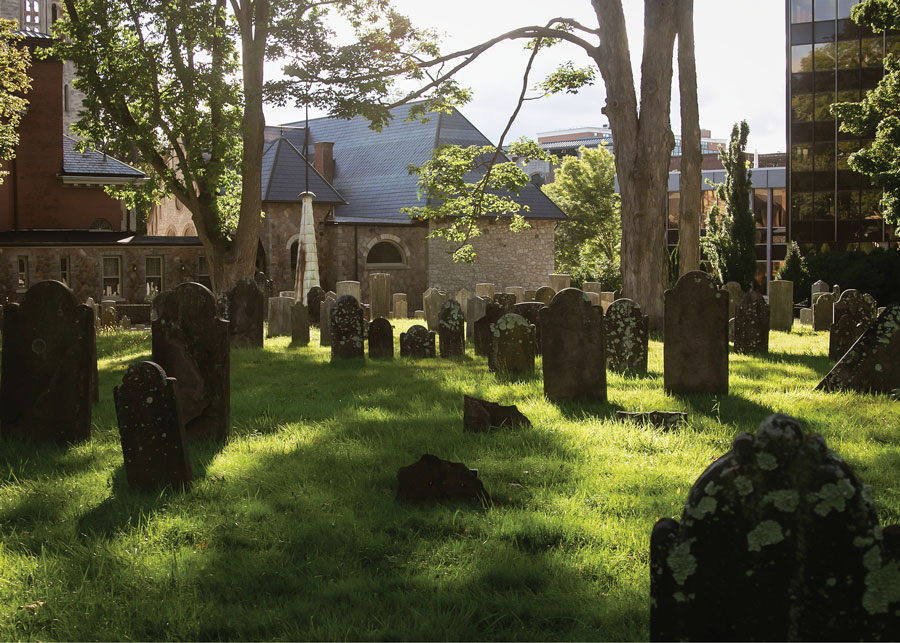
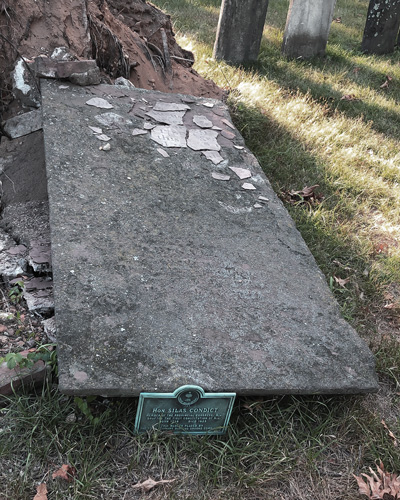
Condict rested in peace for 195 years, until Tropical Storm Isaias arrived in August, 2020. When the gale toppled one of the many massive ancient trees that thrive in this secluded oasis in the middle of downtown Morristown, Condict’s grave was entangled in the roots, causing his tombstone to be completely shattered, and his bones (presumably) to be uprooted! For the time being, all there is to mark his final resting place (which may not even be where his actual remains are) is a small plaque over a pile of woodchips. Yards away, a tarp covers his smashed-up tombstone and his first wife, Phoebe, whose own tombstone lays on the ground, forgotten.
A visitor walking around the Burying Ground will recognize two things right away: a lot of gravestones corresponding to Morristown street names such as Mills, Cutler, Condict, DeHart, Vail and Phoenix (to name a few); and what the ravages of time and nature can do to a place. For each tombstone that is in good condition there must be two or three that are severely deteriorated or destroyed. Another victim of the last summer’s toppled tree was the grave of Major Joseph Lindsley, also known as the Powder Maker, who as operator of the Ford Powder Mill supplied gunpowder to the Colonial Army. Besides damage from falling trees, heavy rains have caused graves to slide down from the graveyard to Spring Street below on multiple occasions. These bodies would be moved to Evergreen Cemetery, the most famous of which is Reverend Timothy Johnes, who was the first and longest-serving pastor of the Presbyterian Church and who gave George Washington the Sacrament of Holy Communion during his stay in Morristown.
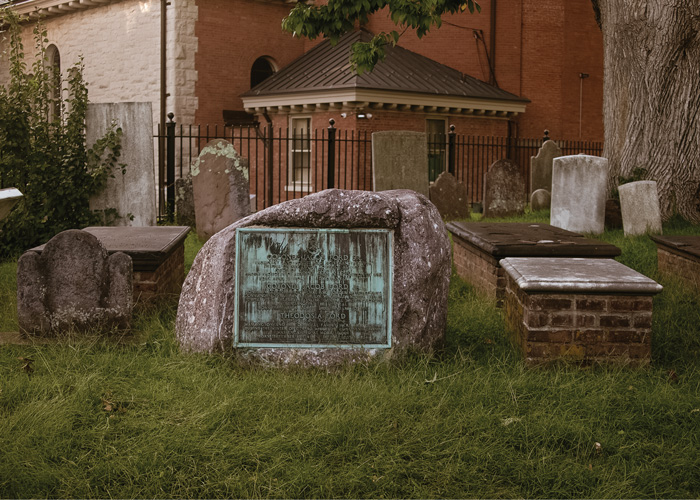
While these unfortunate events seem to have insulted the sanctity of this place, we should feel lucky that there are still many tombstones in good condition that have tales to tell, serving as a valuable historic record of local Colonial-era life. The Ford family plots near the front of the graveyard are still in fantastic condition. After leading a successful skirmish against British forces near Springfield, Jacob Ford Jr. died—not from wounds, but pneumonia—on January 10, 1777, and was given a funeral with full military honors ordered by General Washington. Next to Jacob is his father, Jacob Sr., another colonel in the NJ Militia who voted on the delegation to the First Continental Congress. He passed away only nine days after his son’s death. And there is Theodosia Ford, Jacob Jr.’s wife, who after losing both a father and mother-in-law, her husband, and her youngest child all in a six-month span, had to serve as host during George Washington’s stay at the Ford Mansion in 1779 – 1780.
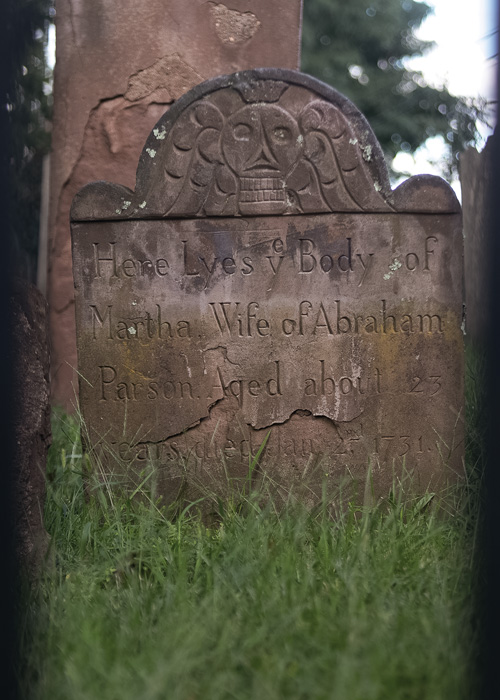
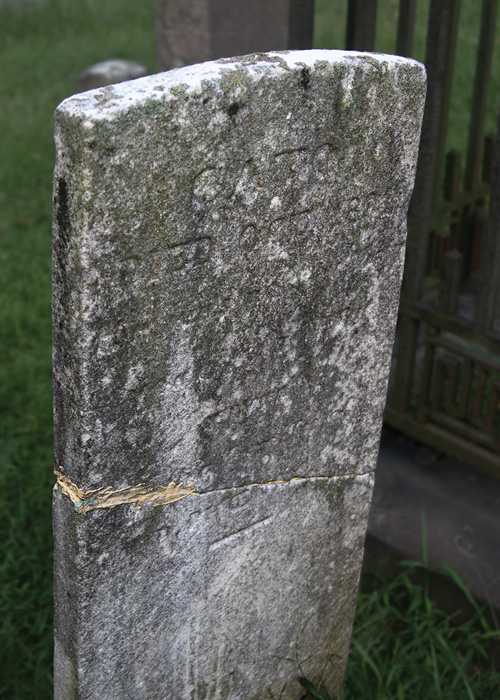
The grave of Jacob Arnold, who is known for owning Arnold’s Tavern, the other headquarters of George Washington during the winter of 1776 – 1777, is still standing strong next to his wife and mother, while just a few yards away another famed Morristown tavern owner’s grave, Peter Dickerson’s, has not been so lucky, having been broken off at the base. Dickerson’s Tavern was located at the corner of Spring and Water Street and was the site of the court martial trial of Benedict Arnold.
There are hundreds of Revolutionary soldiers buried in this graveyard, most in a mass grave for victims of an outbreak of smallpox in 1777 that took the lives of around 150 soldiers along with 68 members of the church’s congregation. Veterans of the War of 1812 and the Civil War are also buried in the graveyard, the most prominent being Hayward G. Emmell, one of the original members of the Independent Hose Company of Morristown and whose journal during the Civil War is cited as an important document.
Near the back of the cemetery is the Phoenix plot which holds the remains of Daniel Phoenix Jr., a major during the Revolution, and his son, Jonas Phoenix, who spent four years in congress representing New York. Besides the iron fence that protects their family plot lies a grave of a man named Cato who, as the inscription says, spent “forty years a faithful servant,” otherwise known as a slave. Cato isn’t the only slave buried here but is the only one whose marker is still standing.
On the left side of the cemetery, you can find the plot of the King family. Here lies Frederick and son, Harry, who were the first two postmasters of Morristown and Henry’s son, William King, one of the founders of the Morristown Library, serving as its first president until his death in 1888. Next to the Kings is the Vail plot where Congressman George Vail, brother of Alfred, is buried. Near this area you can also find William Alexander Duer, a president of Columbia University, and Jacob Mann, the co-founder of the Farmer’s Almanac who started printing the paper in 1818 in Morristown.
All this history and these prominent people are stashed away behind the Presbyterian Church in Morristown, next to the busiest section in the busiest town of Morris County! Take a walk through the Burying Ground for some peace and quiet, and to learn a thing or two. It is well marked with explanatory signage. But watch out for falling trees!
Even today, if you needed a natural hideout—a really good one—Jonathan’s Woods could work.
Paths of green, fields of gold!
The Jacobus Vanderveer house is the only surviving building associated with the Pluckemin encampment.
Dedicated to preserving the heritage and history of the railroads of New Jersey through the restoration, preservation, interpretation and operation of historic railroad equipment and artifacts, the museum is open Sundays, April thru October.
The Millstone Scenic Byway includes eight historic districts along the D&R Canal, an oasis of preserved land, outdoor recreation areas in southern Somerset County